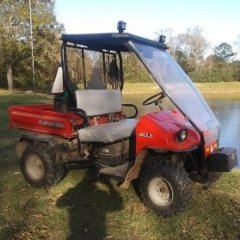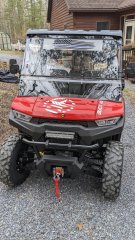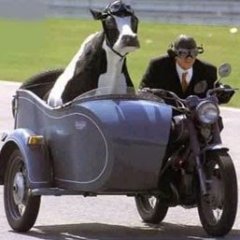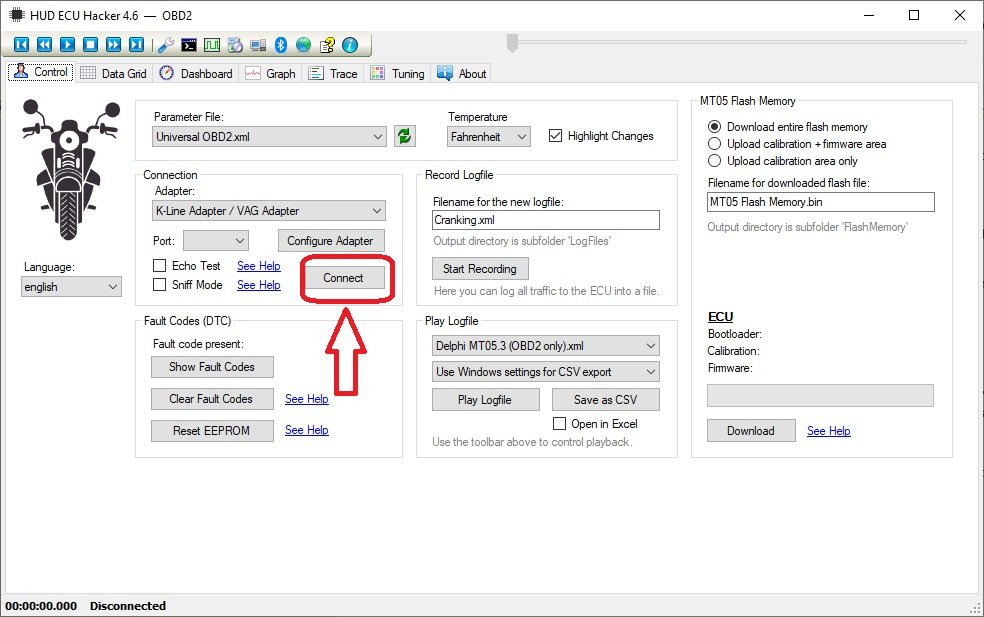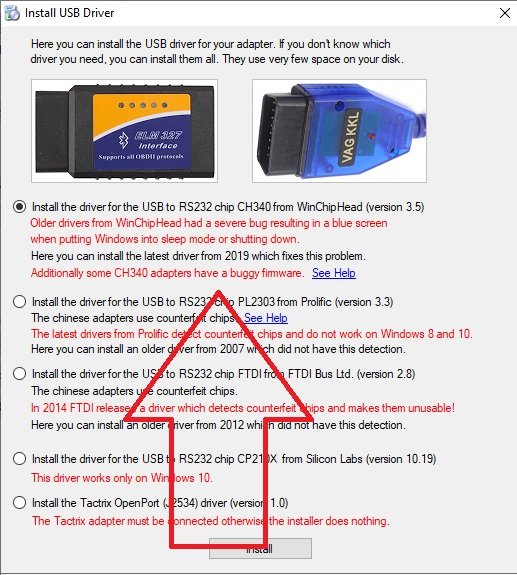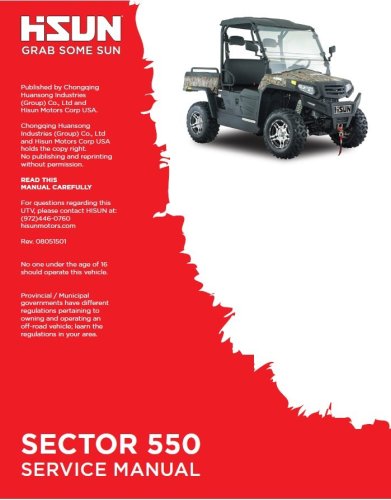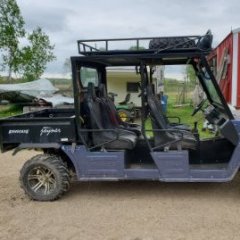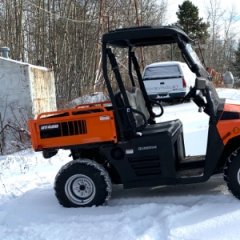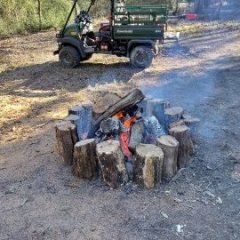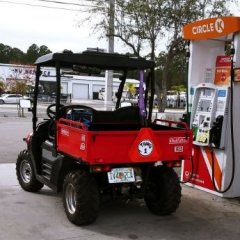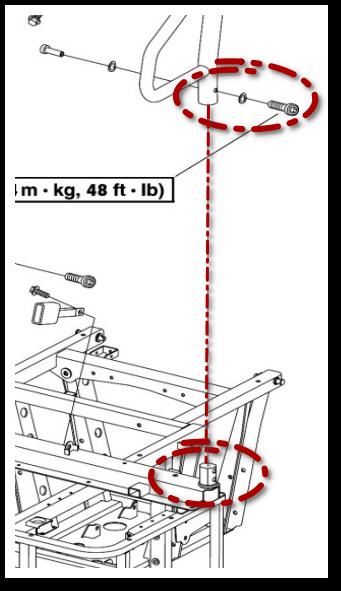Leaderboard
Popular Content
Showing content with the highest reputation since 04/25/2023 in all areas
-
Since I've seen some questions on this I took some pictures and will provide instructions on a valve adjustment for the UT400. This should be the same for the 550's and other various Coleman/Hisun single cylinder models with the cylinder slanted aft. I have seen several people ask of it is really necessary, and read several reports of valves being out of adjustment from the factory. My valves were .004" intake, and .010" exhaust with about 5 hrs on the machine. I've seen different numbers thrown around for factory spec, but I decided to go with 0.005". This is called valve lash. What is is is a gap between the rocker arm and the valve then the camshaft isnt opening the valve. Why does it matter? If it's too large the valve doesn't open all the way, if it's too small the valve dosent close. This can cause valve damage (overheating) as well as loss of engine power (burned fuel is going out exhaust rather than pushing the piston dow). Tools required : 5MM Allen wrench, 10MM box wrench, needle nose pliers, flat feeler gauge set, rags First you need to remove the fan cover on the passenger side. There is a cooling vent hose on the back side, remove the hose clamp and slide it off. From there there are 4x 10mm bolts holding the cover. The forward ones can be accessed from under the seat. Next remove the spark plug from the drivers side. Carefully wiggle the spark plug wire off. Grip it as low as possible and give it a little twisting motion as you pull it off to help free it. Its a tight fit for a socket, but there is a sheet metal wrench in the toolkit that fits it. Unscrew the plug and set it aside. This allows you to spin the motor over freely with no compression to fight. When you reassemble this is a good opportunity to switch to an NGK iridium plug for better performance/less fouling DR8EIX) Next you need to remove the intake and exhaust valve covers. The intake us the forward one. There are 3x 5MM Allen screws to remove. The Exhaust is the rear with 2x 5MM Allen bolts. Both covers have O-Rings instead of gaskets and are reusable. When you remove the rear be careful and use your rags as there will be oil that drips out. Next up we need to spin the motor over to top dead center. Grab each rocker arm and give em a little wiggle up and down. Spin the engine over by grabbing the fan with your other hand. Spin the engine over until both rockers have some wiggle and are loose. Once both rockers are loose slide the feeler gauge in like shown above. Try different feelers as needed to determine your starting spec. You should feel some drag but still be able to move the feeler without too much force. If you need to adjust, use the 10MM wrench to slightly loosen the locknut, then with the correct feeler gauge in place, tighten the top square nut while wiggling the feeler in and out. Once you have it right you need to tighten the 10mm lock nut without moving the square head bolt. Once the lock nut is tight recheck the clearance. That's it, button everything back up and make sure you have it all reassembled before running it again. If you find this helpful give me a thumbs up or comment. If you have any questions or need more help let me know. If there's interest maybe I'll do some more of these4 points
-
Hello to anyone who reads this. I am Jon and I own J&M Outdoor Power, a very small, small engine repair shop. I was approached by Coleman about 6 months ago to become one of their Warranty Centers. I recently received 3 different UT400's and a UT500 all with similar issues. These units range from 2 months to 2 years old. Customers state that the unit(s) was/were running fine, then heard a pop and a loss of power, two would no longer start. The two that would run would not achieve normal operating speed (around 20mph I would say) without redlining the RPMs. I quickly found that the Valve lash on each unit had become too large on some(both intake and exhaust) and too tight on one(just intake). After setting the gaps to .005(I found multiple different people suggesting bigger and smaller gaps, but no definitive Coleman Spec number yet) every unit starts, runs, and achieves top speed without issue. I don't know how many others have come across these issues, and I wanted to get something out on the web for others in the same predicament. Please let me know if you have had similar issues. Edit: I realize that this will not be a fix all solution for this issue, as the oil level and condition should be verified before moving to the valves. Many times improper oil conditions will cause valve lash to change. These units all have good oil and proper oil changes.3 points
-
Are you talking about an electric heater? if yes its likely too much current. There might be 10 amps of available current coming out of the rectifier that isn't already claimed by the ECU and factory lights. 10 amps @ 12V = 120 Watts, which is about what an electric heating pad runs. If you're talking about a fan for a engine coolant based heater it's probably ok. If you have accessories and the running voltage is below 13.5V you have too much stuff attached. If the battery light comes on it means the battery is actively being discharged while running. Stator based charging systems on these things and tractors etc are really meant to power the ECU and factory systems not to provide a lot of extra power for other stuff, it's not like the alternator on a car.2 points
-
2 points
-
The main trick is tilting the front end up. Block the rear wheels and jack up the front end at least a foot. A convenient ditch works well also.....rear wheels in a shallow ditch. The head bleeder screw should be opened. With the engine NOT running, almost fill the radiator (leave some air to avoid a mess) and burp (squeeze the lower hose line before the metal tube at the engine base passenger side floor area). Watch the radiator and the the bleeder. With the radiator "higher" than the head bleeder, the air should be bled and coolant dribble out. Close the bleeder and refill radiator (your clue you displaced the air with coolant) and start the engine. Burp more while running and if you get the circulation going the hoses will warm up. More bubbles should surface at the radiator filler neck. Shut off engine. Open bleeder and release any air in the head. The puke jug needs to be filled about an inch above the full cold line. Use a shop towel as a "seal"and use an air nozzle to SLIGHTLY pressurize the puke tank removing the air from the tubing line to the radiator neck. Then the radiator starts to overflow, a third hand can install the radiator cap. Run the engine and determine the head and hoses are at the close to the same temperature (as in warming up) through out the system. IR temp gun....fairly cheap now....can get real numbers. Scan the radiator, hoses, cylinder and head.....if all close you are done. Recheck fluids when done riding. Recheck the bleeder and top off the puke jug as required.2 points
-
From the look of the picture on the post, I can think of a couple things2 points
-
Its' not a car, this is a motorcycle engine with a small stator charging system. You can't expect to run high wattage accessories like a heater or huge light bars on these things . That will overwhelm the charging system, drain your battery an stop your engine. Could damage the charging system and voltage regulator too. You only have about 10 amps extra to run any accessories including lights.2 points
-
My dealer gave me an electronic version of the service manual and I have sent it to Kingfish. I will see if it will upload here for others to use. I'm not sure if there is a more appropriate way to do this, let me know if there is.. 2015-2017 Service Manual - Sector E1.pdf2 points
-
my Hisun in my Massimo , sold by Tractor Supply, assembled in Dallas, say Made In China on every part of all of it .. Altho it now has multiple Yamaha parts mixed in. lol2 points
-
https://motorcycledoctor.com/wp-content/uploads/2021/08/Valve-Adjustment-HiSun-2.pdf This should do it.2 points
-
Yeah, I adjusted mine multiple times without any luck. I had extended the shifter rod, as mentioned on this board, as well as some videos I watched, and that resolved the shifting issue. Now, after it slips into forward or Reverse, it never slips out. PS: If you go this route, remember to readjust the cable to compensate for the extended shifter. I had to do the adjustment an couple times after extending the shifter and then the problem was resolved.2 points
-
I finally found a service manual in stock and was able to make the adjustments per the specs!2 points
-
Problem was using cheap eBay injector. Bought quality one and hot pipes went away. Running like new.2 points
-
2 points
-
Massimo MSU500 won't shift to low I would check the shift linkage. Adjust it make it a little longer, if it is not long enough it won't shift to low2 points
-
Hello again! I now have a pretty good running Coleman UT400 after a top end rebuild, wet clutch rebuild and a repaired crankcase... ! It plows snow great, but I was also having the jumping out of gear problem, mainly reverse, but a couple times out of forward. I would quickly place it in N and then let the engine idle down and shift again. This worked most of the time. I did some research and found that some have modified the shift linkage. The problem with just adjusting the shift cable is that it really NEEDS more throw, not an adjustment. From what I've read and viewed on the Internet, the linkage arm needs to be about 3/4" longer to gain more throw in both directions. On YouTube, the guy had to remove the shift linkage hole trim and notch the side of the dash to get the shift linkage off the pivot pin. BUT this is NOT necessary. When the "E" clip has been removed and you fish it out of the firewall somewhere, the shift lever is now loose. I had to pop the top of the shift knob off, remove the retaining screw and then heat the lower portion of the knob to get it to come off the lever. Once you have the shift lever loose, push it towards the right to slide it off the pivot shaft. But it won't come off just yet. Use a small pry bar/screw driver and slide the nylon flanged bushing out of the left side of the lever. This lets the lever slide off and get into a "loose" condition and it will twist and come right off without removing the dash trim, that could be a bugger to get back on correctly. Once the lever is off, press out the other bushing so when you're welding on the linkage arm, you don't melt the bushing. I found a piece of scrap metal the same thickness as the lever arm, just over 1/8" thick, close to 3/16". I cut my arm and beveled the edges for better welding. I added a piece just over 5/8" long and kept about a 1/16" gap between the arm and the new piece. Once welded on bother ends, it adds up to just about 3/4" or so. I reinstalled the lever after painting it and did an adjustment on the cable. By the way, it's easier to remove the cable from the bracket on the frame. This gives you more clearance to maneuver in that area with your hands. ALSO, you will need to get a 12" adjustable wrench and slide it over the cable mounting bracket and tweak, to the front, the steel so the cable is pointed upward a bit to now realign with the new longer shift arm lever. There's more than enough metal for the tweak and it will line up perfectly. I now bottom out the shifter on the transmission BEFORE I run out of throw on the shifter... I've tested it just a bit so far and it shifts much better with the longer throw. One of the Coleman authorized repair facilities said that he worked with Coleman to get a new part that's longer by 3/4". He's modified a few and it works perfectly for him. Just doing the cable will just short you on the other end. Here's some pictures of my modified shift lever etc.2 points
-
In order to connect with the ECU we need two cables. The first is a USB ODBII cable. HUD ECU Hacker’s documentation has a lot of different confusing options, but here’s what I went with and managed to get working, the cable is called “VAG KKL” it is a USB to ODB2 cable. It is available from a variety of sources for $10-15. The second thing we need is a “6 pin delphi to ODB2” adapter cable. It is also available for a similar price. In my case I ordered both from ebay, but there are other sources. Once we have our cable in hand we need to find the plug it in on your machine. My personal rig is a Coleman UT400, but the wire location should be similar for all Hisuns. My cable was located under the middle of the seat area. Just inboard of the battery, where the main wire harness split loom runs. The cable is a 6 pin (3x2) with a dust cap. Remove the dust cap and plug in the 6-pin end of the Delphi adapter cable. Note: When I was done, I left the 6-pin adapter connected, and zip tied it so it now runs to in front of the battery for easier access in the future. Next download and install HUD ECU HACKER DOWNLOAD Open HUD ECU Hacker on your PC It should prompt you to choose a driver to install. This particular cable uses the “CH340” driver (First choice on the menu) click to install, once installed hit the X in the corner to go back to the main page Once the driver is installed plug in the USB Cable, and plug the ODB2 end into the 6 pin adapter. The red led on the adapter should light up indicating it has power. Drop down and pick a com port on the main screen, it should show the VAG KKL adapter as a com port. Click connect on the main menu. It will pop up a bunch of fast scrolling text indicating it is connecting. Once connected you can click through the various tabs to see different data sets. The main menu also has the option to show fault codes, clear fault codes, reset the EPROM back to factory. The other function that may be helpful is recording a log file. You can record a log while operating the unit, and come back later and replay it to try to better diagnose what is happening. Within the various pages you will see the reading from each sensor. Sometimes a sensor reading will be off enough to cause running issues, but not enough for the ECU to realize its an issue. For example if the engine thinks it’s really warm, but its actually cold, it may not inject enough fuel to start. There are also more advanced functions, like adjusting fuel mapping, but that is beyond the scope of this tutorial. Full HUD ECU Hacker Documentation (Very technical reading) If you find this helpful give me a comment below or a thumbs up.2 points
-
While I can fully understand Joe B's unhappy experience and his recommendation to go elsewhere, I believe that his unit is/was a HiSun. Those units have been shown to be very suspect, and Massimo was way undercapitalized to support the dealer network and their customers. On the other hand, my 2020 T-Boss 500-F (with the steel box w/dropdown sides) is a Linhai chassis. Except for a few design quibbles (front hood access, oil change mess, inadequate hitch mount and excessive reach with the steel box, overly bright display at night, etc), I have found that the Linhai version to be a solid, reliable, entry-level SXS. I've had the steering wheel loosen up (6 Phillips head screws) and the windscreen brackets needed realignment. I also replaced the 300 CCA U1 Lead acid battery that was OEM, with a 350 CCA AGM U1 battery. That solved the occasional cold start stall and kick back against the starter. The OEM flooded lead acid battery is just too small. Works OK in my lawnmower, though. 😒 I use mine for general banging around my land that has somewhat rough terrain, and I am also equipping as a fast-response vehicle to fight remote wildland fires. Bottom line is that I wouldn't ever consider buying a used 2019 or earlier Massimo or any other brand that uses the HiSun chassis of any vintage. 🏁1 point
-
By "small body tank" do you mean carberator bowl? If so you might have a fuel pump issue. I'm not familar with the carbed models do they have an electric pump? have you tested the pressure on the fuel line? is there an inline filter?1 point
-
DON'T BUY A MASSIMO! The quality is soooo bad! I have a 2021 550 TBoss new when inventory of the decent brands was at rock bottom. I paid new what used decent brands were selling for. I quickly learned why. The quality is soooo bad. Out of the gate I had to make numerous adjustments to get it to run, drive and operate smoothly. Couldn't tow anything because the hitch receiver snapped off, the cheap plastic guards in front of the suspension parts broke off in no time, flooring cracked after a bit of use, windshield is now un clear and unusable after cleaning a couple of times (yes, I was extremely gentle), And all of the above and more on a machine I barely use (very low miles) I would love to sell it and buy a good one some day but I don't think anyone would buy it. Listen to all of the advice above and stay away from this brand!1 point
-
Try playing with the adjustment. The 500/550's don't have the same shifter cable/lever issues as the 40's but the cable can stretch over time. If you're getting grinding and popping out of gear it could be worn clutch dogs too, which require some effort to replace as they're internal to the transmission. If you're having shift issues and grinding it's best to be proactive about adjusting because it does damage the dogs over time, and eventually will just pop out of gear at will once the dogs are rounded enough.1 point
-
1 point
-
I have a 3500LB Winch that only runs in one direction. Inward but not Out. Replaced the solenoid module. Makes "click" when I push the "Out" button and the motor tries to spool out but then stops and begins to "click". Does anyone have suggestions what I should try next?1 point
-
We see a lot of the UT400 with shift problems, not going into gear, popping out of gear, grinding etc. There is a bulletin Im sure everyone has saw about adjusting shift cable. That dont always fix it. I went round n round with coleman on couple units. We are a Coleman warranty repair center"AFS Small Engine Repair " I told them shift lever does not have enough travel . No amount of cable adjustment will increase travel . I extended lever with piece on flat iron by 3/4 of inch . This gave shifter enough travel to properly engage into gear completely . Last couple units to come in for this Coleman sent me a modified shift lever, with longer travel . Problem solved! Also , heads up if you get any new unit ,,,go over and check it out, grease all zerks, check air filter for being in backwards, check wiring harnesses for rubbing on rotating parts, brake hose routing , make sure not touching exhaust . These are just few of the more common failures I see .1 point
-
you'll have to get the axle nut off first. 1 1/16" If i remember right. the trick to getting the stuck drums off on these 550's is pb blaster,a hammer, and patience. also wouldn't hurt to open the bleeder on the back of the wheel cylinder to relieve any pressure.. spray the PBlaster between the drum and backing plate, let it sit and soak, and moderately tap around the drum, mainly focusing on the area around the cylinder... patience is KEY.1 point
-
Higher octane fuel burns slower and prevents knocking and pinging. Also it tends to have a longer shelf life before it breaks down. If your model is equipped with antiknock sensor you will find a noticeable performance increase with high octane fuel due to automatic timing advance to take advantage of the fuels burn time. Regardless it never hurts to run higher octane fuel and for the amount powersports equipment burns price is really negligible. I try to run nothing but premium in anything but my truck... for both performance and incase it sits for a month or more.1 point
-
Look at the "Man Hole" threads and you will find a cut into the threads, line this up to the flywheel timing marks and that will be your TDC.1 point
-
Take the spark plugs out and turn the engine over by hand while doing that get a screwdriver and stick it in the spark plug hold and fill for the piston when it comes to the top that is tdc then adjust the valves1 point
-
Electric power comes from mechanical power. The charging system is small so it doesn't rob too much horsepower, not because it's cheaper to do it this way.1 point
-
Just a idea about an senior and good aftermarket charging system company that has salvaged some new sales failures for a friend. Charging system puked in a few hours after purchase. That takes the shine off of a new unit. Rick's to the rescue. Design wise, the stator is made "light" on the windings so the regulator can be lower cost build....i.e.....cheap as is the "power runs in the OEM harness. The regulator used is a waste excess charging current system. The excess current is shunted to ground over and above that required for the 13.6V ish to charge the battery and run accessories. A higher wattage stator will need a higher wattage regulator. $$$$$$$$ We used Rick's for years.....the latest "problem" I heard about was a xmxmxmx unit that had a strong stator but the voltage regulator used for certain models dies and the regulator is on national back order. NEWLY SOLD UNIT IS UNUSABLE and NO LIGHT AT THE END OF THE TUNNEL. Rick's built up a "custom" regulator to fix the problem that xmxmxmx Engrs could not or would not fix. It is a multi-year screw up so there was time if Rick's worked up a winner in a week why not the OEM Engrs. Contact Rick's and spec a hotter stator and a matching better regulator. Warning: I have had to beef up the stator wires and regulator supply and gnd wires over the stock OEM wiring harness for some real headlights on street bikes.....too much drop in the cheap wiring runs. Just saying, you might have to do some harness upgrades also. Rick's Motorsports Electrics ricksmotorsportelectrics.com1 point
-
1 point
-
1 point
-
Hi there…one of the few disappointments with my new side by side is the low beam lights. They seem to be little more than driving lights. Is this a common complaint amongst owners? Rufus1 point
-
1 point
-
Would like to let everybody with the 23' Z Force units know that Spring Brake Thingy now has a parking brake available for these units. Pretty easy install, the brake pedal does need to come off for a couple holes to be drilled, but that's not all that difficult. These are all made here in the states, like all of our other models. see it at: http://springbrakethingy.com Mods: if we need to do something as a vendor please let me know, couldn't find any info and don't want to brake any rules......1 point
-
It is Hisun assembled in Texas. They may have some specially spec'd parts but most everything is interchangeable from experience with my Bennche 700.1 point
-
Well, the subject says it all! After the motor stopped, I went out and bought gas and filled the tank. Tried to start and it just cranked - no fire. I assumed I had spark, because nothing changed there. I pulled the plug and could not smell gas. The plug was dry. Put it back in and tried to flood it by piumping the pedal, but it was still dry when I took out again. The gas gage red fuel lights didn't seem to recognize that I filled the tank (see previous fuel Haugen posts). Disconnected and reconnected the negative battery terminal hoping it would reset any interlocks that might be set. Now the ignition panel will not light up when ignition turned to "On". Things are getting worse instead of better! Have the fuse panel open, will check fuses tomorrow. Can anyone help me get back on track? No shop here in Tucson will work on it! Nice unit. But you're on your own for maintenence. Thanks for any help!1 point
-
Go to Motorcycledoctor.com click on advice & knowledge and scroll down until you see your model. Click on your model and at the bottom of the page he will have schematics of your system. You'll need to be able to use a voltage/ohm meter and read a schematic.1 point
-
Joe. I looked over the instruction link I posted above and it just states the following: "Next up we need to spin the motor over to top dead center. Grab each rocker arm and give em a little wiggle up and down. Spin the engine over by grabbing the fan with your other hand. Spin the engine over until both rockers have some wiggle and are loose." From my experience, TDC would be when the intake valve is at it's highest point and not spinning the engine until the rocker arms have some wiggle. What procedure did you use to find the TDC?1 point
-
1 point
-
No idea, as you will find out, Massimos are a do it yourself project, no help from the manual or the factory. I can't help you now because mine is a at my farm 160 miles away.1 point
-
This is all to to me as well, I can't say I know the answer to that, wish I did though. When I turned the soleplate I noticed the squeak. I did like I said and noticed the squeak went away. At that point I was happy and unfortunately I didn't really pay attention to how freely it spun. I am going to need to do some maintenance here soon as I'm starting to hear the squeak again, its not as bad , but its there. It could be just in need of some cleaning.1 point
-
ECU Rev Limit.cdr (motorcycledoctor.com) This should take care of it. Check out his advice & knowledge page which is where I got this from.1 point
-
Thanks for stopping by. I live out in the country and wanted to get a good Side By Side to get around my land and the local township I live in. I picked up a '23 bobcat UV34XL (Gas), and I hope I don't bug anyone with all the Questions that I will/may have.. I look forward to reading and having conversations with everyone.1 point
-
Don't worry too much about the steering wheel alignment, for now that is. Do your toe in adjustment and while the outer tie rod end jam nuts are loose, you can take the six steering wheel cover off with a 4mm Allen wrench. Loosen the nut holding the steering wheel on and unthread it so it's flush with the end of the steering shaft. Use your knees or have someone lift up hard on the steering wheel while you hammer the nut/shaft to break it loose. I use two hammers. One ball peen hammer on the end of the nut /shaft and use the second one to hit the first one. A couple good whacks and the steering wheel will come loose. Then unthread the nut and pull off the steering wheel and realign the shaft splines and the steering wheel to make it straight again. You may have to readjust your tie rods a bit to get true center on the steering wheel. I adjusted my toe IN to about 3/16" on each side. Also, you'll have to release the two inner tie rod boot cover outer clamps so the tie rods can turn without winding up the rubber boots. Don't forget to reclamp the boots. I said a lot of words, but it's really quite simple. Good luck, Dan1 point
-
Chris, thought I'd throw this out to will until more informed members help you out. There are some here that have more knowledge on these things than Myself. I own a 2016 MSU 800. In 7 yrs I have very few problems with mine. Mainly brake pads which I consider a wear item and wheels bearings a couple times. Mine has sealed wheel bearings as opposed to roller bearings that can be maintained, the only maintenance of sealed bearings is run them until they wear out and replace them!! On me machine if it gets to where it doesn't shift well it's usually the adjustment on the shifting linkage, which in my opinion is quite touchy, therefore it doesn't take much for it to get out of adjustment.1 point
-
I currently have a 2011 Polaris 400 H.O. that has fewer than 300 hrs on it. My buddy bought it new and I bought it with around 100 hrs. I use it around the farm and to get between two properties that are about a mile apart. I am tired of dealing with the choke when its cold or even cool out. It starts fine and runs ok if your driving but until it gets completely warmed up if you pull up to a gate and get off to open it will die. And because of the choke my wife has a hard time with it. Before I got the 400 I had a 2013 polaris 500 midsize that was fuel injected but aways ran rich and foul plugs. I had it at two different dealers and neither one could fix it. So I sold it and bought the 400. My father in law has a 2015 Polaris 570 midsize which is fuel injected and it is hard to start and cranks more than it should. Needless to say I am done with Polaris and ready to sell mine and move on to something better. I have been looking at the Honda Pioneer 700 and the Kawasaki Mule Pro MX. I was disappointed to learn the Kawasaki Mule Pro MX engine is built by Hysun and not Kawasaki, but that maybe a non issue. Maybe I'm missing another good option that I haven't considered. The main thing is getting something that is bullet proof reliable. Any feedback would be greatly appreciated. Thanks in advance1 point
-
This may work. Works for my Axis which is made by hisun just like the Massimo. Begin with the machine off. Cycle the key on and off 5 times within 5 -10 seconds. Making sure the fuel pump kicks on each time. After the 5th key off. Wait 30 seconds then start. Should be reset.1 point
-
The real problem, as I see it, is that the codes given are consistent with an engine that's running poorly. So imho, if it's not running with a substantial miss, then something else is going on. Like a possible failure of the CPU. Manufacturers are typically reluctant to give away parts without a reliable, trusted diagnosis of failure, such as that provided by an authorized service center. And a new CPU could be quite expensive, with no guarantee that'll cure the problem. Throwing parts at it is never a good plan anyway. Fixing it yourself, could be a long, expensive, frustrating endeavor. Complete with long down times, and fairly involved diagnostic procedures. If it were me, I'd try to make it Lowe's problem. By any means necessary, including a return.1 point
-
I have been meaning to write this up for some time. As delivered (in late October 2020) my 2020 UT400 had the expected number of loose "final assembly" nuts and bolts, but even after tightening down everything it still had an annoying metal-on-metal rattle--one f those that was quite audible but difficult to locate. it sounded like some chassis or suspension component but I could not pin it down. So, I took to carrying a large rubber mallet with me and stopping and banging on things when it really got to me. Eventually I tracked it down to the rear uprights for the roll cage moving about on their mounting posts. The left and right rear cage posts slip onto forged steel hubs welded to the frame and were cross-bolted with some very pretty 10 mm dia. binding post type fasteners having an 8 mm threaded internal shank (the Service Manual says they should be torqued to 48 lbf·ft but when I tried all I got was a violent and quite loud "pop" as the head ripped off the female end): Examine the torn apart section and it's obvious why it could not handle 48 lbf·ft. Here's how it mounts, from the service manual; So, I replaced both binding bolts (pretty but not up to the task) with a plain ol' 10 x 1.25 x 50 mm class 10.9 bolts and self-locking nuts; and had at torquing it again--no problems, the cage upright squeezed up tight on the forged post and the rattle was gone making me a "happy 'UTVer'"...1 point
This leaderboard is set to New York/GMT-04:00




